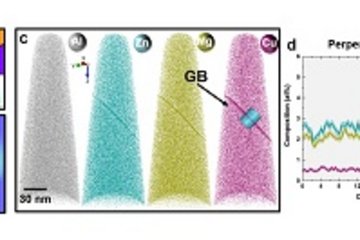All genres
81.
Talk
Cementite decomposition in 100Cr6 bearing steel during high-pressure torsion: Influence of precipitate composition, size, morphology and matrix hardness. European Congress and Exhibition on Advanced Materials and Processes, EUROMAT 2021, online (2021)
82.
Talk
On the decomposition resistance of carbonitride precipitates during high-pressure torsion in X30CrMoN15-1 bearing steel. High Nitrogen Steel conference, HNS 2021, online, Shanghai, China (2021)
83.
Talk
Mechanism of cementite decomposition in 100Cr6 bearing steels during high pressure torsion. MSE Congress 2020, virtual, Sankt Augustin, Germany (2020)
84.
Talk
Moving cracks form white etching areas during rolling contact fatigue in bearings. MSE 2020: Conference takes place exclusively over the Internet (2020)
85.
Talk
The role of carbon in the white etching crack phenomenon in bearing steels. MSE Congress 2020, virtual, Sankt Augustin, Germany (2020)
86.
Talk
Investigation of cementite dissolution in 100Cr6 bearing steel under high pressure torsion (HPT). Materials Science and Engineering congress, MSE 2020, online, Darmstadt, Germany (2020)
87.
Talk
Material alterations in intense mechanical and chemical contacts. TMS 2020 Annual Meeting & Exhibition, San Diego, CA, USA (2020)
88.
Talk
Joint Nanoscale Structural and Chemical Characterization by Correlative Atom Probe Tomography and Transmission Electron Microscopy. Joint Workshop on Nano-Characterisation (4TU.HTM / M2i), Utrecht, The Netherlands (2019)
89.
Talk
κ carbide microstructures and the role of interfaces in high-Mn lightweight steels. High-Mn Steel 2019, Aachen, Germany (2019)
90.
Talk
Atomic scale analysis of grain boundary deuteride growth front in Zircaloy-4. TMS 2019 Annual Meeting and Exhibition, San Antonio, TX, USA (2019)
91.
Talk
The role of carbon in the formation of white etching cracks. Thermes 2018 Annual Meeting & Exhibition, Paris, France (2018)
92.
Talk
Advancing Alloys by Segregation Engineering. 18th International Conference on the Strength of Materials (ICSMA18), Ohio State University, Columbus, OH, USA (2018)
93.
Talk
From Seeing Atoms Toward Understanding Atoms: Methods, Results and Challenges of Advanced Atom Probe Tomography. Hausdorff Lecture, Hausdorff Center for Mathematics, University of Bonn, Bonn, Germany (2018)
94.
Talk
Direct Observations of Atomic Hydrogen and Deuterium Interactions in Zircaloy-4. Atom Probe Tomography and Microscopy conference (APT&M) 2018, Gaithersburg, MD, USA (2018)
95.
Talk
Chemo-Mechanics in Metallic Alloys. 16th Edition of the European Mechanics of Material Conference, Nantes, France (2018)
96.
Talk
Room temperature carbon redistribution in Fe–Ni–C martensite. TMS 2018 Annual Meeting & Exhibition, Phoenix, AZ, USA (2018)
97.
Talk
Atomare Einsichten in Struktur und Zusammensetzung von Stählen durch korrelative Elektronenmikroskopie / Atomsondentomographie. 25. Werkstoffkolloquium des Technischen Beirats, Hannover, Germany (2017)
98.
Talk
Materials Science Using Correlative Microscopy. JFE steel corporation, Chiba, Japan (2017)
99.
Talk
Materials Science Using Correlative Microscopy. Nippon Steel & Sumitomo Metals Corporation, Kimitsu, Japan (2017)
100.
Talk
Materials Science Using Correlative Microscopy. National Institute for Materials Science (NIMS), Tsukuba, Japan (2017)











